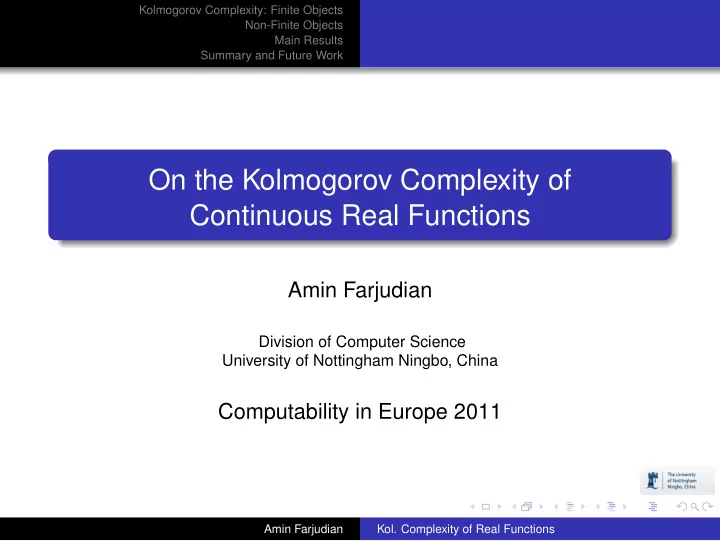

Kolmogorov Complexity: Finite Objects Non-Finite Objects Main Results Summary and Future Work On the Kolmogorov Complexity of Continuous Real Functions Amin Farjudian Division of Computer Science University of Nottingham Ningbo, China Computability in Europe 2011 Amin Farjudian Kol. Complexity of Real Functions
Kolmogorov Complexity: Finite Objects Non-Finite Objects Main Results Summary and Future Work Outline Kolmogorov Complexity: Finite Objects 1 Non-Finite Objects 2 Main Results 3 Summary and Future Work 4 Amin Farjudian Kol. Complexity of Real Functions
Kolmogorov Complexity: Finite Objects Non-Finite Objects Main Results Summary and Future Work Kolmogorov Complexity first introduced by Ray Solomonoff around 1960 also known as descriptive complexity originally defined over finite-objects can be used to study how ‘compressible’ a finite sequence of 0 s and 1 s is Amin Farjudian Kol. Complexity of Real Functions
Kolmogorov Complexity: Finite Objects Non-Finite Objects Main Results Summary and Future Work Kolmogorov Complexity: Example We do not always have to write down all the elements of a sequence to describe it. For instance, we can describe the following sequence of digits in fewer than 100 characters: x = 111 . . . 1 � ���� �� ���� � 100 In fact, one can simply describe x in fewer than 25 characters as ‘a sequence of 100 ones’ . Amin Farjudian Kol. Complexity of Real Functions
Kolmogorov Complexity: Finite Objects Non-Finite Objects Main Results Summary and Future Work What About Non-Finite Objects? Consider the compact interval [ 0 , 1 ] of real numbers. For each x ∈ [ 0 , 1 ] , there is a Cauchy sequence � x n � n ∈ N such that: ∀ n ∈ N : | x n − x | < 2 − n lim n →∞ � x n � n ∈ N = x The binary expansion of x gives us one choice for this sequence. π − 1 = lim < 0 . 0 2 , 0 . 01 2 , 0 . 010 2 , 0 . 0101 2 , . . . > Amin Farjudian Kol. Complexity of Real Functions
Kolmogorov Complexity: Finite Objects Non-Finite Objects Main Results Summary and Future Work Kolmogorov Complexity of Real Numbers: Cai and Hartmanis [CH94] As the binary expansion is one candidate, then: ∀ n ∈ N : K ( x n ) ≤ n For the real number x , the Kolmogorov complexity K R ( x ) can be defined as: � � K ( x n ) K ( x n ) K R ( x ) ≔ 1 lim inf + lim sup 2 n n n →∞ n →∞ It should be clear that ∀ x ∈ [ 0 , 1 ] : 0 ≤ K R ( x ) ≤ 1 Amin Farjudian Kol. Complexity of Real Functions
Kolmogorov Complexity: Finite Objects Non-Finite Objects Main Results Summary and Future Work Some properties of K R Cai and Hartmanis [CH94] prove that: (i) For Lebesgue-almost every x in [ 0 , 1 ] , K R ( x ) = 1. (ii) For every t ∈ [ 0 , 1 ] , the set K − 1 R ( t ) is uncountable and has Hausdorff dimension t . (iii) The graph of K R (which is a subset of [ 0 , 1 ] × [ 0 , 1 ] ) is a fractal. Amin Farjudian Kol. Complexity of Real Functions
Recommend
More recommend